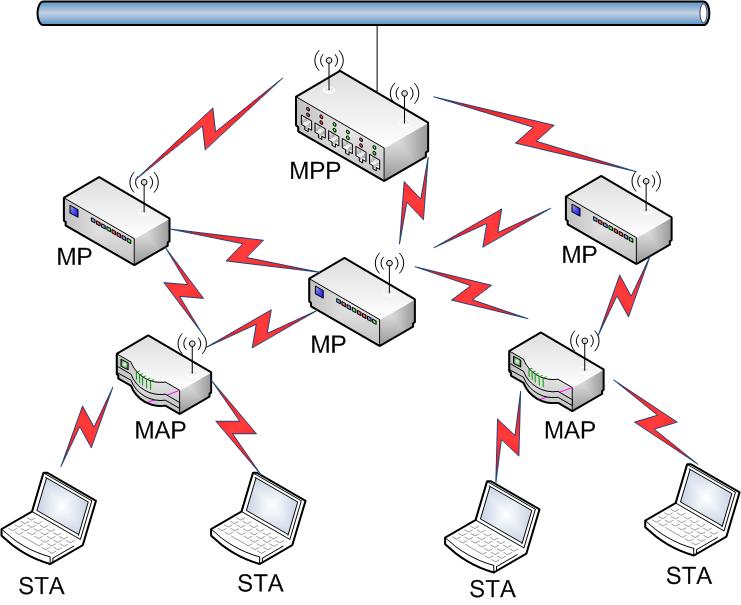|
|
WiFi mesh networks
Recently, wireless mesh networks have been considered for IEEE 802.11 WLAN, also known as WiFi, networks due to their flexibility and cost-efficiency. Typically, an extended service set (ESS) of IEEE 802.11 consists of multiple basic service sets (BSSs) connected through a wired distribution system (DS). Each BSS includes an access point (AP) and its allotted wireless stations (STAs), while the DS provides the wired connectivity between APs and to wired LANs. Conversely, an independent basic service set (IBSS) interconnects STAs without using any AP and DS. Unlike BSS, an IBSS is not able to connect to a wired LAN but it is able to provide self-configuration and other ad hoc networking benefits. IEEE 802.11s, known as WiFi mesh, has been proposed to combine the advantages of BSS and IBSS by means of relaying capability of so-called mesh points (MPs). Fig. 1 illustrates an example WiFi mesh network architecture, where a mesh access point (MAP) is a special type of MP with the additional capability of an AP and a mesh portal (MPP) works as a gateway device to the DS.

|
|
|
Fig.1. WiFi mesh network architecture.
Two types of WiFi mesh network topologies are considered in the IEEE standard 802.11s: single-channel and multi-channel topologies. In a single-channel topology, all of the operational wireless frequencies are the same, while in a multi-channel topology the mesh backhaul can work in different frequency channels by using multi-antenna devices.
One of the important challenging issues considered in IEEE standard 802.11s is routing. Early IEEE 802.11s drafts considered the following WiFi mesh routing protocols at the MAC layer: (i) hybrid wireless mesh protocol (HWMP) which is mandatory, and (ii) radio aware optimized link state routing (RA-OLSR) which is optional. However, in the latest drafts (from draft 1.07), the optional routing protocol has been neglected.
HWMP is a hybrid routing protocol combining on-demand routing and proactive tree-based routing, which work for mobile and fixed stations, respectively. The airtime cost is used as a routing metric which measures the quality of wireless links. The ad hoc on-demand distance vector (AODV) routing protocol with the ability of supporting extensions has been specified as an on-demand routing protocol of HWMP.
Despite the importance of WiFi mesh networks, the IEEE standard 802.11s finalization has been postponed due to various challenging issues such as:
- Topology learning, routing and forwarding
- Discovery and association
- Security
- Medium access coordination
- Interworking, configuration and management
- Compatibility to 802.11 services
|
|
|
|
|
|
|